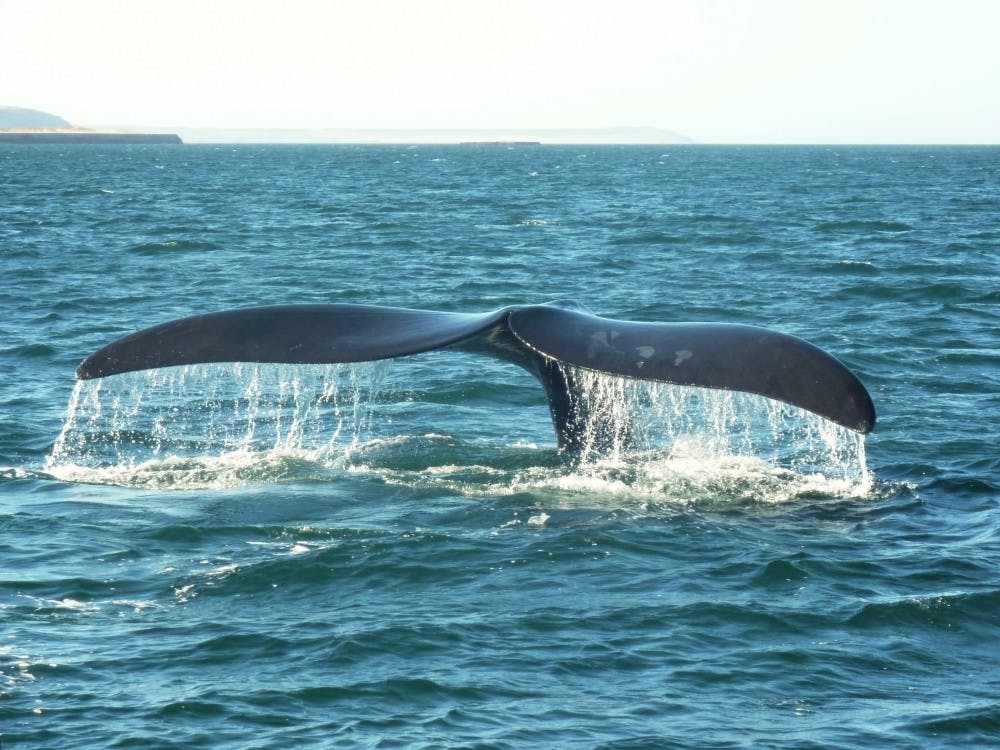Considered the “right” whale to kill a few decades ago, North Atlantic right whales are now one of the most endangered species of marine mammals.
A new study by a Duke researcher looks into the detection and monitoring of vulnerable right whale populations. Douglas Nowacek, Randolph K. Repass and Sally-Christine Rodgers University professor of conservation technology in the environment and engineering and Susan Parks, associate professor of biology at Syracuse University, discovered that new mother whales “whisper” when communicating with their calves—a revelation that could spell the difference between life and death for this small population.
“There isn’t significant documentation of this whisper activity in other species of whale. This is not to say it doesn’t happen,” Nowacek said. “There’s just not a lot of documentation of mother blue whales or sperm whales with their young.”
Their research team mostly tagged female right whales, monitoring the individuals that live off the coast of Jacksonville and northeast Georgia. This location is the prime spot for right whales to have their babies, and mothers tend to remain there with their calves for a few weeks after birth.
Parks and Nowacek’s analysis found that female vocal repertoires shift dramatically before and after they have their calves, reducing to a “whisper” when “speaking” with their young.
Nowacek said that one of the quickest applications of this discovery is in passive acoustics monitoring techniques. Passive acoustics, which have been refined over the past 10 years to detect right whale calls, is a practice that usually consists of placing sonar buoys into the water to pick up on the location of whale calls.
This method has been suggested as a means of monitoring whales and whale activity around coastline military sites, as well as activity near offshore oil and gas development or seismic surveys. By determining the distribution of nearby whale populations, this technique hopes to mitigate any harm to this endangered animal.
However, if the right whale mothers and young that frequent these areas aren’t making as much sound or any sound that can be picked up by passive acoustics, they could end up impacted or impaired.
Calves are the ones at risk of predation, Nowacek noted, as they are small, young and dependent on their mothers. Acoustic disturbance from sonar scans and seismic surveys are another stressor on the population, as he mentioned the potential effects that additional noise from sonar can have on mother-calf communication.
“If they’re only producing really quiet sounds and they get separated, and the background noise level is increased by one of these activities, if that calf can’t find its mom, then it’s as good as dead,” Nowacek said.
As of now, right whales are classified as endangered by the International Union for Conservation of Nature (IUCN). In recent years, the IUCN has been considering changing the right whale’s red list status from endangered to critically endangered, Nowacek added.
He said that there are about 400 right whales and only around 100 reproductive females left. In addition to the potential danger of noise pollution, he mentioned that anthropogenic threats such as fishing gear entanglement and ship strikes are killing the whales faster than the population can reproduce.
“It doesn’t take a model to tell us that the population is suffering severely from our activities,” Nowacek said.
He highlighted that one of the next steps is to see how far and how long this reduced acoustic behavior persists as the whales make their way up the coastline. From a policy perspective, he said that the study informs future sound-based techniques of monitoring whale movement and distribution.
Nowacek also discussed the social influence that the species has had on people like those in Beaufort and around the Duke University Marine Lab.
“If you look at the crest for Carteret county where we live at the Marine Lab, it has two right whales in it,” he said.
The Shackleford Banks near Beaufort used to be choice hunting grounds for right whales, but there was a shift in the relationship between the community and whales after hunting right whales was made illegal in 1935.
“They’re clearly an iconic species,” Nowacek said. “This work and other work is really focused on trying to protect the remaining animals that are out there, and we need to act fast.”
Get The Chronicle straight to your inbox
Signup for our weekly newsletter. Cancel at any time.

